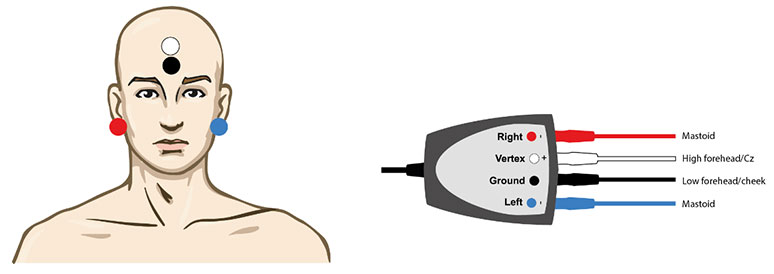If you’re concerned about your hearing or have been referred for further assessment, you may have come across the term Auditory Brainstem Response, often abbreviated as ABR. This is a type of hearing test that evaluates the function of the auditory pathway from the inner ear to the brainstem.
What is an ABR Test?
The ABR test is a sophisticated hearing evaluation that measures how well sound travels from your ear to your brain. Unlike traditional hearing tests where you respond to beeps or tones, the ABR doesn’t require any active participation from you. Instead, it uses advanced technology to record your brain’s response to sounds.
Importance of ABR Tests in Audiology
Auditory Brainstem Response (ABR) testing is a game-changer for spotting hearing issues early on, especially in babies. It’s useful for newborn screening programmes, as it can pick up hearing loss when traditional tests just won’t cut it.
Why’s that so important? Well, if you catch hearing problems early, you’ve got a much better chance at helping a child’s speech and language come along nicely. ABR doesn’t need the little one to do anything – it works even when they’re fast asleep or not in the mood to cooperate.
This test isn’t just for the babies though. It’s helps older kids and adults who struggle with regular hearing tests. By taking a peek at how the auditory nerve and brainstem are doing their job, ABR helps audiologists figure out what’s going on and how best to tackle any hearing issues.
How is an ABR Test Done?
The test usually takes about an hour, though it can sometimes be longer. It’s painless and non-invasive, but you’ll need to remain very still during the procedure to ensure accurate results.
You might be asked to avoid caffeine before the test, as it can affect brain activity. Some people find the test relaxing, and you may even doze off, which is perfectly fine!
The ABR test typically follows a structured procedure to ensure accuracy and reliability. Here’s a step-by-step overview:
- Electrode Placement – The audiologist will first apply surface electrodes to specific locations on the patient’s scalp, forehead and earlobes using a conductive paste or gel. These electrodes are painless and simply record the brain’s electrical activity in response to sound.
- Stimulus Delivery – The patient wears earphones through which a series of clicks or tones are presented. The audiologist adjusts the stimulus intensity (loudness) and repetition rate of the sounds as needed.
- Waveform Recording – As the sounds are presented, the electrodes detect the faint electrical responses generated by the auditory nerve and brainstem. These responses are amplified and displayed on a computer screen as waveforms.
Source: Auditory Brainstem Response Test
Are There any Risks From ABR Tests?
The ABR test is considered very safe. There are no known risks associated with it, and it doesn’t involve any radiation or invasive procedures. The electrodes placed on the scalp merely record the brain’s natural electrical activity in response to sound.
Preparing for Your ABR Test
First off, don’t stress – it’s a straightforward procedure. The main thing is to arrive at your appointment with clean, dry hair. Skip the hairspray, gel, or any other products on the day because small electrodes will need to be attached to your scalp. Hair products can interfere with getting a good connection.
It’s important to be relaxed for the procedure and if you manage to nod off during the test, that’s fine. It’s also best to avoid caffeine as this tends to increase brain activity which can affect your test results.
Finally, if you’re on any medications, keep taking them as normal unless your audiologist says otherwise.
Role in Neurological Diagnoses
Beyond its use in analysing hearing loss, ABR testing can also help with neurological diagnoses.
It helps spot and track certain brain and nerve issues, like multiple sclerosis, tumours, and strokes, by checking how sound signals travel through the nervous system.
The test can also indicate problems with the hearing nerve itself or where it connects to the brain. By looking at the timing and size of specific waves in the test results, neurologists can pinpoint where the trouble is and how bad it might be.
Closing Thoughts
The ABR test is a valuable tool in assessing hearing health. While it might sound complex, it’s a straightforward and comfortable experience for most patients. By understanding what to expect, you can approach your appointment with confidence, knowing you’re taking an important step towards better hearing health.
Sound Hearing is a London based audiology practice. If you are experiencing hearing problems or would like independent advice on hearing aids, book an appointment with us.

